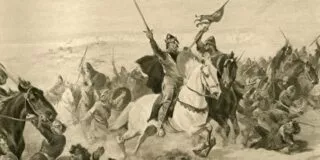One of the most important battles in English history remains to be the Battle of Hastings.
This battle was when the last Anglo-Saxon King, Harold, fell to William the Conqueror during his conquest of England.
Even though it took place almost 1,000 years ago, it changed the future of England forever.
But how much do you know about this important fight?
Check out these 30 facts about the Battle of Hastings that will surprise you!
The power struggle over the English throne happened when King Edward, the previous King of England, died without having any children to be his successors.
10 years before King Edward died, he promised his cousin, William, that he would be the successor to the throne.
While King Edward was on his death bed, he ended up granting the kingdom to Harold who was the head of the most powerful noble family in England. William immediately disputed the claim but did not invade England until 9 months after Edward’s death.
The Battle of Hastings was fought on October 14, 1066, between the Norman-French army, and the English army. This battle started the Norman conquest of England.
The Battle of Hastings didn’t take place in Hastings – it took place about 7 miles northwest of Hastings in a town now named “Battle.”
The first person killed in battle was the jester, Taillefer, of William the Conqueror. The jester was juggling his sword while singing to the English troops. An English soldier tried to challenge him when Taillefer killed him and charged alone into the English lines.
Both of the sides took a break for lunch. Though there was no official break, there was most likely a lull in the battle during which point, both sides regrouped to discuss their tactics and had lunch.
The battle was unusually long for a medieval fight, lasting from 9 A.M. until dusk.
Genealogists have found that about 25% of the English population is descended from William the Conqueror.
The French soldiers used an ancient method called “feigned flight” which entailed the Normans pretending to flee from the opposing English soldiers. This mislead the English forces to break formation and make themselves vulnerable to attack.
It is a common myth that King Harold died from getting shot in the eye with an arrow. However, historians are confident that he died by being beaten to death.
The Anglo-Saxons were vastly outnumbered by the Normans. William’s army from Normandy totaled to 15,000 men while Harold only had about 5,000 men.
Most of the Anglo-Saxons continued fighting even after Harold was killed. They had made a promise to fight until the very last man was killed, though some of them did flee.
There are many factors behind why King Harold lost, one of the main reasons being that William was a more experienced military leader.
It wasn’t until around 200 years after King William’s death that he actually started being called “William the Conqueror.”
The location of King Harold’s body remains unknown to this day. There is an alleged gravesite at Waltham Abbey, but the precise whereabouts of his body is still disputed today.
In order to reach Hastings, the Normans sailed about 700 ships across the English Channel.
After King Harold was defeated, William of Normandy was crowned the King of England on Christmas Day, 1066.
William promised that if he won the battle, he would build an Abbey. He remained true to his word and placed the high altar at the same spot where King Harold was killed.
The bodies from the side of the Norman bodies were buried in a large common grave, which location remains unknown.
Although William spoke French and grew up in France, he was a descendent of Viking origins.
William invaded England two weeks before the Battle of Hastings to claim his right to the English throne.
While most of the English army was on foot, around 1/4th of the Norman army was on horses which gave them a huge advantage.
After William won the battle, there was a language barrier between him and his English subjects. William only spoke French, while the court only spoke English.
William changed the language of the court to French, and because of this, brought many French words into English. This evolved into modern English that we use today.
After the battle, a tapestry was made to commemorate William’s victory. It is called “The Bayeux Tapestry” and depicts many details about the battle.
The tapestry is 20 inches wide, and is the length of about 3 swimming pools which makes it the longest piece of embroidery in the world!
Even after the Battle of Hastings, the surviving English leaders resisted for a few months, which was why William wasn’t crowned king sooner.
To this day, there are yearly reenactments held of the Battle of Hastings, on or near the site of the battle. It draws in thousands of spectators from around the world.
The reenactment is the largest gunpowder reenactment in the world. Previously, it was done by amateur groups of reenactors but has recently included more professionals.
So there we have it. There’s no question that the famous Battle of Hastings was an incredibly important event in English history and made the country what it is today in many ways.
We have summarized the whole fight for you in small easy to digest pieces and with a little luck, we have learned a lot from this event and something like this will never happen again.











